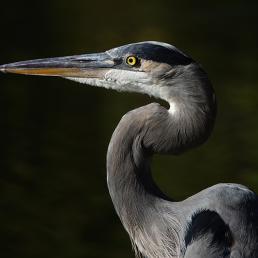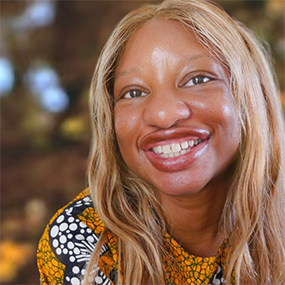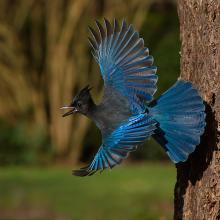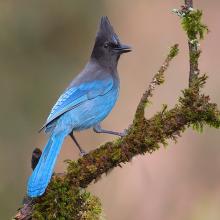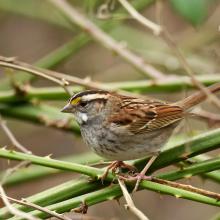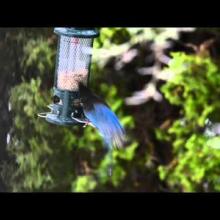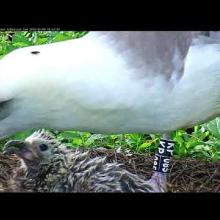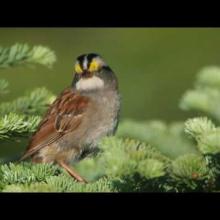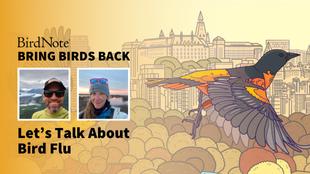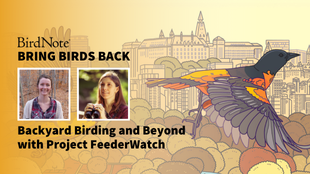

Join BirdNote tomorrow, November 30th!
Illustrator David Sibley and actor H. Jon Benjamin will face off in the bird illustration battle of the century during BirdNote's Year-end Celebration and Auction!

Love is in the air and we’re not talking about your $4.99 Valentine’s Day balloon! For this special episode of Bring Birds Back, we dive into all things bird love! Doves may be the universal bird symbol for love, but romance in the bird world is happening all around. Our guest Wenfei Tong shares various ways birds are wooing each other by song, dance, gifts, and more. From choosy lovers like the Laysan Albatross to opposites-attract lovers like the White-throated Sparrows, bird love languages are real and well documented.
[French romance music plays]
Tenijah Hamilton: Well, hello there! I’m Tenijah Hamilton and it’s fancy meeting you here during the off-season. It’s just that it’s Valentine’s Day, and I was feeling a bit lovey-dovey. And I mean that in the strictest, ornithological sense. For this special bonus episode of Bring Birds Back, we’re talking all about romance in the bird world and we have a return guest from last season — biologist and writer Wenfei Tong. She literally wrote the book on bird love — like, it's called "Bird Love: The Family Life of Birds."
We're going to look at some fascinating ways that birds choose their mates — their bird love language, you could say! We’re talking choosy lovers like the Laysan Albatross, mirrored lovers like the Stellars Jay and opposites-attract kind of lovers — like the White-throated Sparrows, just to name a few!
Like us, some birds have their own set of needs and desires in the quote-unquote “dating stage” — like the need to be wooed! Wenfei takes us on a journey sharing the ways birds share their desire to love one another by singing, dancing, gift-giving, nesting, and more.
Let’s jump right in.
[French romance music ends]
Tenijah Hamilton: We often hear about birds looking for a good mate, right? And I'm curious about what makes a good mate for a bird. Is it different depending on species? When we're talking about mating season, how do we know who the optimal mate is?
Wenfei Tong: Yeah, totally depends on species. So, some will go for just, who's going to give me the best genes to pass on to my kids. And in those cases, the male often doesn't do much. And so the female is basing her choice largely on signals that the male is of good quality. So that she can make a good investment in her kids, right? Or have a good co-investor in the kids.
All the way to the other end of the spectrum, where both parents have a lot to do in terms of raising the kids. And so, very often it's a case of mutual mate choice, and it's everything from do we get on to, are you going to really be good at helping me raise these children? Everything from making a nest together or feeding the kids together, or if you're a complicated bird with a long lifespan, teaching them something as they grow older.
Tenijah Hamilton: I just can't help imagining like two birds sitting, you know, across from one another in a bird bath and thinking about, okay, like how do we connect? And where do you see yourself in five years? And how many chicks do you want?
Wenfei Tong: [Laughs] Well, you know, there've been studies where people have shown that in certain species, I think Steller's Jays, like tends to attract like. Biologists have these ways of measuring animal personalities. And it turns out that if you've got two relatively shy, novelty averse individuals, they're more likely to pair up than, one with a very bold, outgoing risk taking Steller's Jay.
And then in other species like these White-throated Sparrows, you've got different personalities that are actually linked to different plumage types. And in those cases, opposites do best together. I don't know if they always attract, but they definitely are the ones that are successful in raising kids. So you tend to see a very outgoing, slightly aggressive, bird paired with a more shy introverted bird, for want of a better word, that also tends to be more conscientious about the parenting and that's regardless of sex. And, in the case of the White-throated Sparrows, the ones with white stripes on their heads are the more aggressive, outgoing ones. And the ones with tan stripes on their heads are the more, inward, careful, quiet, good parent ones.
Tenijah Hamilton: How? I mean, how did evolution do that? How?
[Playful electronic music begins]
Wenfei Tong: [Laughs] It’s so cool, right? Well, If you get into the genetics, it's very cool, actually. It's related to how sex chromosomes probably evolved, which is, you know, in species that have eggs and sperm or, or sex in general, every time, egg cells or sperm cells are made, the genes undergo this random shuffling and then the deck of cards, the deck of genes gets halved.
And so in that process, almost everything gets shuffled except for certain chunks of the genome that have what we call an inversion. That means that its partner can't find it to swap cards with, which is exactly what happens with something like a Y chromosome, right? There's nothing for it to pair with. So it can't exchange genes with anything. And so a father's Y chromosome will be inherited intact by his son and so forth.
Other bits of the genome that have these inversions have the same intact inheritance from generation to generation. So that's how you can automatically link something that controls plumage color to something that controls personality in this case.
Tenijah Hamilton: My mind is kind of blown. Who knew? I mean, surely people know, you knew, obviously you're wise.
[Playful music ends]
So I feel like on every nature documentary I watch, right, there's kind of an obligatory scene where one bird is trying to woo another bird and there are really cool mating behaviors happening, where they're trying to attract them. So I'm thinking specifically of courting dances. I'm interested in A: are they really dancing? Is that a bird behavior? And, if that's as common as it seems in a world of nature documentary?
Wenfei Tong: Probably not as common as the nature documentaries might make us think because from watching nature documentaries, you might think that's the main way birds attract mates. And that's probably not true for a majority of birds. It's most common among birds that can afford to spend a ton of time and also energy making spectacular feathers, and then putting out them on display with a dance, in a place that they're not worried about being gobbled up immediately or something. So it's actually relatively rare behavior.
Tenijah Hamilton: These are privileged birds.
Wenfei Tong: Yeah. And, you know, you tend to see it in places like Papua New Guinea, where it's an island. And you've got a whole lineage, birds of paradise, where every species has its own elaborate dance and dancing grounds and amazing plumage that makes them extremely vulnerable to all sorts of predators that are typical of other large continents.
That's answering the ‘how common is it’ question. But are these dances? I would say they are just along the lines of, we are not so different from birds. So if you define a dance as some kind of expression of your inner compulsion to move in a spectacular, rhythmic way; I'm sure that all these birds that dance would not dance unless they also evolved some motivation for performing those movements. So whatever that motivation is, that kind of brain drug, that hormonal drug that makes dancing pleasurable would have to have evolved for them to perform the behavior. And so there, I don't see it as very different from why humans dance, like we dance because we find it fun, right? I bet the birds do that too.
Tenijah Hamilton: That is, again, really perspective shifting. In an attempt to make a lame joke, you know, The Killers they ask, are we humans or are we dancers? We might be birds.
Wenfei Tong: Yeah. Or we're all dancers. But there's also another functionally different dancing where it's less to woo a particular mate on a kind of dance floor, performance setting, but more of a mutual, almost like renewing of, vows or something, which goes on among birds that bond for a long time.
So I'm thinking about things like albatross or grebes, where the dancing is a synchronized Pas de Deux— ballet term, but you know, two, really working on their moves and they work on them again, and again, and again. And they go through the moves at every important point in their history together. So if they're at the point of making a nest, they'll go through the moves together.
Or if they're seeing each other between trips to find food for the kids and they meet at the nest they go through the moves again together or something like that.
I remember seeing the albatross in the Galapagos where part of their mutual dance together, involved a bunch of bill clacking and also this very cute, probably what counts for singing in the albatross world, where they open their, bills wide and go, ‘ahhh’ together in synchrony and then close them and then click the beaks really fast, like castanets. Click, click, click, click, click, click, click, click, and then both of them would bow their heads and then they'd start the whole dance again.
But, that resonates a lot with human long term monogamous relationships, right? Where you're cementing these bonds.
Tenijah Hamilton: Absolutely. And I love the way you describe it as, kind of a vow renewal. It's really beautiful when you think of it that way.
Wenfei Tong: And also it's sometimes extremely comic. So sometimes in a lot of nature documentaries, you see birds like grebes are quite funny when they engage in these synchronous dances, where a couple will look like they're just skimming across the water and it looks like their heads are almost upside down, but, it's both balletic and very elegant and quite comic at the same time.
[Soft, curious, and slightly sweet clarinet music starts]
Tenijah Hamilton: So there's a bird that even in the earliest part of my bird journey has really fascinated me. And it's the albatross, which you were just talking about. And for me, and in my personal life, uh, for the longest time, uh, for four or so years, my partner and I were in a super long distance relationship and he lived in New Zealand and I was here.
And I remember when I first started getting into birds, I was like, oh, we're the albatrosses because they stay together for life and they travel long distances for each other. I, um, have always been able to romanticize the birds in my head. So I would love for you to talk more about the albatross and the lifelong bonds that they form.
Wenfei Tong: They do. And not only do they form lifelong bonds, they live a long time. So their development and the time it takes some of the albatross species to find a partner, their life mate, almost like a soulmate, can last up to, I think in some species it's like almost 10 years or something in some individuals. Or maybe even 20. But that's for the species where, you know, an albatross can live to 80, which is very much a human lifespan.
But also albatross bonds can run the gamut. So we've got a really interesting group of albatross that people have been studying in Hawaii that are Laysan Albatross, where biologists noticed after a while that there were some pairs that had two eggs, and this is just crazy in albatross biology, because it's so expensive for one female to lay an egg that there's no way a single female is ever going to lay two eggs at a time. And so the two eggs in the nest implied that there were probably two females bonded and taking care of that nest and taking care of a chick that would subsequently hatch. So what's fascinating about that case is not only are the albatross able to form these long term pair bonds with all the ritualized, synchronous, courtship moves and renewal of vows and everything with the opposite sex.
But in some cases they do it with the same sex, two females raising a kid together. And unfortunately with this Laysan Albatross, it's the case that two adults can only raise one kid. So in that case, it's always one female's kid that's going to lose out and die. So that's a slightly sad bit of the kind of same sex relationships and long term pair bonds in Laysan Albatross. And that's a study that's still going on where there are basically way more questions than there are answers. But yeah, this capacity to form long-term pair bonds, and to really partner in all the work that raising a kid entails and then to keep the bond going for years is very cool and can be extended to both heterosexual and homosexual pairs.
Although there are no instances of two males raising kids because they wouldn't have a kid to raise.
[Music fades out]
Tenijah Hamilton: So another bird, again now I’ll relate this back to my life, that has made an appearance is the Northern Mockingbird. We have a couple trees outside of our house. And during the spring, I believe, we had a bird who, bless his heart, was singing all night long.
And we were like, little bird, what's going on? Um, what's the problem? And he would just sing and sing and sing. And I think one day we Googled it. ‘cause we were like, something is happening. This is not normal. He's the only one singing at like midnight. And we Googled it and Google called him “increasingly desperate.” Because breeding season was coming to wrap up and he needed a mate. So apparently from my research, this is common behavior when mating season kind of begins to wrap up and they don't have a mate, they get increasingly desperate and do this all night vocalizing. Can you tell me anything about this behavior? And is it very common or what's happening here?
Wenfei Tong: Well, I guess we should take a step back. A lot of birds, majority of birds sing to attract a mate. And the Mockingbird is like one of the champions of this because they're mimics. And so they're also what we call open learners. So most songbirds cement their songs, their repertoire, when they're pretty young. And they learn it from their dad or, you know, other males around the nest. And that's the only song they can sing for the rest of their lives. And that's the only tool they have in the arsenal for wooing females.
Whereas in the case of things like mockingbirds or catbirds or thrushes or canaries, they keep learning throughout life and they keep incorporating new sounds into their songs. And so a mockingbird will mimic all sorts of other birds. Like part of what the females seem to be selecting for is a diversity in the male's repertoire.
So that's, that's a very cool aspect of like, maybe it's worth just enjoying the song, even though I'm sorry, it kept you awake. Um, I mean, I have a parallel instance where my husband used to complain about being woken up by a bloody robin at 4:00 AM every single day. And I think the Beatles song, “blackbird singing in the dead of night” is referring to the same phenomenon.
That's a European blackbird. It's actually in the same genus as the American Robin. And they both have this compulsion to sing a lot. So I think, yeah, Google probably is partly right that this is likely to happen a lot more when the birds are a bit desperate.
The more immediate explanation is that they're ramped up on hormones and so that hasn't died down yet and the hormones make the males want to display and sing. And so they just keep doing it.
It's a, it's a bit like the incentives for dancing. The hormones make it this pleasurable activity, or almost addictive activity. And so at that time of year, they just keep doing it. But that's more about the mechanics of how it might keep happening rather than the long term evolutionary advantage for the behavior.
Tenijah Hamilton: So it seems like we have dance. We have singing, two things to attract a mate. What other techniques do birds have to woo a partner?
[French romance music starts]
Wenfei Tong: So some of my favorites are just the actual goods in exchange for a partner. Or demonstrable signs of wealth. So everything from: I've just got this really great property and you, you girls have to come and settle. I've got a wonderful nest that I've built and please come stay in it and raise our kids in it.
Or a very immediate gift like food. Fish in the case of Osprey is often something that's used to either woo someone or cement the relationship even after the female’s accepted you as a partner. And then the other kinds of gifts I love are the very stylized ones where it's not obvious that a piece of let's say a flower petal or a piece of fluff or a cigarette butt is going to be that attractive, but somehow it works for some birds to have these little tokens, these symbols.
Tenijah Hamilton: Yeah, is it penguins who give little shiny pebbles?
Wenfei Tong: Yeah, I think some penguins, and there were some babblers, arabian babblers I think exchange pebbles. And Ravens. I mean, because Ravens are so smart, it's almost like every individual Raven or Raven pair has its own preferred group of tokens, so sticks or bits of moss or stones of a certain cast, something like that.
The other very famous example of course is a close relative of birds of paradise, the Bower Birds of New Guinea and Northern Australia, which build these architectural wonders. These creations that we call bowers. And they fill them with a whole art collection, a gallery of objects that they've lovingly collected and curated and arranged in a very particular way so that if you go in and as a human meddle with the arrangement, the male will come back and be like, *tut tut* my bottle cap is in the wrong place and I need to put it exactly back where it belongs. But it's not a nest that the female can functionally use. It's just the male's wooing pad, his, his showhouse or show museum.
Tenijah Hamilton: His Bachelor pad. We love a bougie bird. A bird who is like, I have spent a lot of time curating this collection for you. I think that's kind of sweet.
Wenfei Tong: It's sweet, except, you know, they're really not monogamous, those birds. The females just come through and whichever male is best at attracting a whole bunch of females gets the most kids in the next generation, but they do nothing to take care of the kids, right? Um, it's also funny that the males will steal from each other. So if their, their neighbor has a particularly enviable art piece, they'll, like try and get it. And so that, that piece will make its rounds through all the bowers.
Tenijah Hamilton: What about scent as a way to woo a partner?
Wenfei Tong: That's so cool, partly because most people don't even think of birds as animals that have a very good sense of smell. So we do know that birds like crested auklets, which are like cute little puffin relatives, have a very strong scent during the breeding season. Biologists who are going near the island as they approach an island where these awklets nest on cliffs. You can smell the tangerine scent from the colony as your boat is approaching the island. And they will preen each other and sort of give each other a sniff. So presumably the scent is an important point that birds are using to judge a mate.
Tenijah Hamilton: Mm. Another action which you kind of mentioned so far as to say, this is not what's happening, but nest building. So they can sometimes build each other's nests to kind of attract a mate?
Wenfei Tong: Oh yeah. And actually all the examples I know of tend to be males building a nest to attract a female. Not that it doesn't ever happen the other way around, but I don't know of good documented examples.
So things like weaver birds, which I've watched a lot in Africa, you'll have the trees just covered in these intricately woven nests that the males make. And it's often the meals who weave these nests and it takes them quite a while to do it.
And then the female will come along and assess when the male is kind of sitting on the nest and singing away and advertising that all the females should come and check out his beautiful new creation. And sometimes the female's not impressed and she'll just dismantle the whole thing and make the poor guy start all over again.
Tenijah Hamilton: Oh, brutal.
Wenfei Tong: I know.
Tenijah Hamilton: Um, the last mating behavior I wanted to talk about was singing duets.
Wenfei Tong: Yes. So birds that sing duets tend to be birds that also pair for a long time, or at least for the whole breeding season. So they might be serially monogamous, but when they're bonded they continue that during the rearing of chicks as a way of just keeping an eye on the other parent, it's like, you know, “I'm here. Where are you dear?” And then the other one will reply from somewhere else in the forest. “It's okay. I'm here too”, I guess, is the idea behind those duets.
Tenijah Hamilton: That's really heartening almost. Especially just that last sentiment of: it's okay, I'm here too. It's a big wide world and a big wide forest. Uh, the idea that they kind of call and respond for one another is really sweet.
Wenfei Tong: Well, I'm anthropomorphising shamelessly there. I don't know if that's exactly why the bird is singing.
Tenijah Hamilton: It's okay. We're talking about bird love. We're just, we're just gonna be real, real, givey and takey with all of our interpretations.
Wenfei Tong: Yeah.
[Conclusive romantic italian music starts]
Tenijah Hamilton: So I have one last question for you, and I'm curious if there are any bird love behaviors that especially delight you; that make you feel all amorous in the world. And that's really, you know, either beautiful to see or to experience, or you wish that maybe was a custom in human bird relationships— not human bird— [Laughs] Human relationships. Like I'm curious if there are any bird love behaviors that you like.
Wenfei Tong: Um, well, I mean, all the immediate touchy feely things, like what we call allopreening. So just preening someone else. It's like grooming someone else rather than just yourself. So birds that caress each other with their bills, a lot of parrots and albatross and long term bonded birds do this. That's always really sweet to see.
And then any type of huddling. A lot of birds huddle for warmth, but it does look extremely cute. And it's like this common pool of heat that we all have to benefit from together by squeezing together tight. So I don't know if that's quite love, but it's, it's very cute to watch.
Um, and then more broadly, of course, what warms my heart is all the examples of males either pitching in and doing their fair share of the child rearing or doing most of it or all of it, from the time they've got to incubate or make a nest onto when the chicks are fledged. I find that definitely warms the cockles of my heart.
Tenijah Hamilton: Wenfei, this has been utterly delightful. You have so much knowledge. You are so wise, which is not to say that I'm surprised, but I am — I marvel at it. Thank you for answering our silliest questions and our most lovesick questions. Appreciate your time today.
Wenfei Tong: Aw, thank you.
To learn more about the wondrous ways that birds share love, pick up Wenfei Tong’s book, "Bird Love: The Family Life of Birds.”
And thanks for listening. That’s all for now but not for too long!
“Bring Birds Back” season four premieres this spring! In the meantime, you can connect with us on Instagram @BringBirdsBack. Follow us for show updates, behind-the-scenes content and more! We can’t wait for you all to hear what goodies we have in store.
Bring Birds Back is produced by Mark Bramhil and me, Tenijah Hamilton. Our Managing Editor is Jazzi Johnson and our Production Assistant is Sam Johnson. Scoring is by Blue Dot Sessions.
[Conclusive romantic italian music starts]
